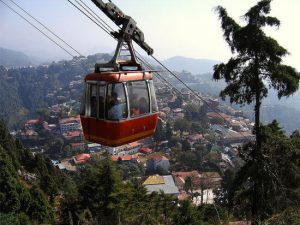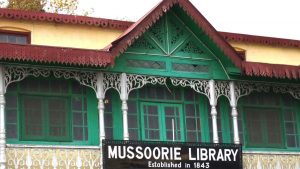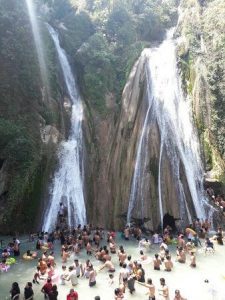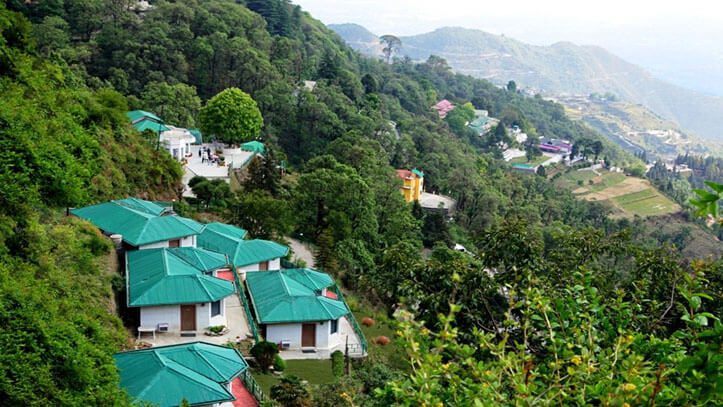Ruchira takes us on a tour of Mussoorie – the place she remembered many decades ago. A recent visit agonised her. The decline and decadence were palpable. An exclusive for Different Truths.
 On a pleasant September morning, many decades ago, our family of four arrived in Mussoorie after an overnight train journey from the Indian capital, which was followed by an interesting cab journey. The journey up the lush green hills, with the car speeding on the serpentine, well-maintained roads was indeed pleasurable. The profuse greenery, the panoramic beauty – rows and rows of misty mountain peaks – coupled with brilliant colonial architecture make the sylvan town an out-of-the-world place. Little wonder, therefore, that it enjoyed the sobriquet Queen of Hills for ages.
On a pleasant September morning, many decades ago, our family of four arrived in Mussoorie after an overnight train journey from the Indian capital, which was followed by an interesting cab journey. The journey up the lush green hills, with the car speeding on the serpentine, well-maintained roads was indeed pleasurable. The profuse greenery, the panoramic beauty – rows and rows of misty mountain peaks – coupled with brilliant colonial architecture make the sylvan town an out-of-the-world place. Little wonder, therefore, that it enjoyed the sobriquet Queen of Hills for ages.
Right since its foundation, serene, sedate Mussoorie had a leisurely unhurried lifestyle. The trend persists even now. Since there is not much activity to undertake around here the place is perfectly suitable for those people who wish to “stand and stare” at the endless bounties of nature.
To get the best view of Mussoorie town, take a cable car ride to Gun Hill the second highest point of this hill town. Treat yourself to dual visual delights
To get the best view of Mussoorie town, take a cable car ride to Gun Hill the second highest point of this hill town. Treat yourself to dual visual delights: of the majestic Himalayan range in the distance and the verdant Doon valley sprawling below. A favourite haunt of nature lovers and shutterbugs.

Located a little out of town, not far from the Mall, Lal Tibba (literally Red Hill) is a must visit. The place is actually a terrace, an extended observation point, jutting out of the hillside; several telescopes dot the terrace, with which you can view the nearby peaks in greater details. On a clear sunny, cloudless day, if your luck holds you may catch magnificent views of a few conspicuous peaks, e.g., Nilkantha peak (in Badrinath), Kedarnath peak, besides the Bandarpoonch range, all gems of Uttarakhand Himalayas. Even the Indo Tibetan border is visible from here.
Another major attraction of Mussoorie happens to be the Camel Back Road, a lovely tranquil promenade where tourists can drink in nature’s beauty in depth. At the end of the three km long road one can view a natural layout of rocks shaped like a camel’s hump. A fantastic creation of Mother Nature! It is obvious how the place got its name.
Bibliophiles must visit the Mussoorie Library.
Bibliophiles must visit the Mussoorie Library. Established way back in 1843, it is a

popular landmark of the hill station which was established only 17 years earlier. Its imposing facade of ornate steel columns, gabled roofs, and chequered windows, reminds the viewers of the “Raj” era.
The Mall Road, at the centre of town, remains the heartthrob of Mussoorie. A relic of the bygone British era it is the central business district and shopper’s paradise rolled into one. A section of the Mall, earmarked for tourists, is studded with sturdy wooden benches and tiny balconies from where the travellers may marvel at glorious sunrises and sunsets overlooking the Doon valley hundreds of miles beneath.
Tourists also throng the famous Kempty Falls a short distance out of town. The sight of the sparkling crystal-clear waters cascading down the undulating green mantle is spellbinding!
It was repulsive to see obese, opulent men and children splashing around amidst the waters of not so old man-made pool.
Sadly, I need to add a postscript here. Just about six years ago, I was in Mussoorie again. The place had changed a good deal. For one, the Kempty Falls had lost its

pristine beauty. What was once a secluded spot had become a commercial one. It was repulsive to see obese, opulent men and children splashing around amidst the waters of not so old man-made pool. The surroundings were strewn with wrappers and plastic bags-boon of commercialisation.
Within the town itself, I was astounded to discover the hotel and lodges had mushroomed everywhere. It was as if you would bump into one, after a few steps. Even the Mall was not as spick and span as it used to be years ago. Also, I was horrified to espy kitchen rags and other washed linen (from nearby eateries and hotels) being hung out to dry on the benches and railings of the balconies, day in and day out. I imagined that the founders of the hill town might be turning in their graves pained by this decadence. The Queen of Hills had been losing its sheen!
Photos from the Internet







 By
By
 By
By
 By
By